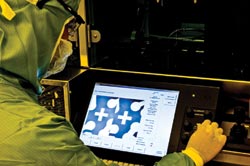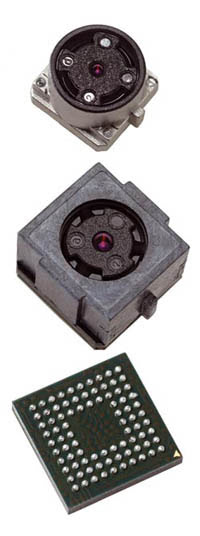From cell phones to digital cameras, consumer applications account for the lion’s share of the image sensor market.
The image sensor market has enjoyed phenomenal growth in recent years. According to market analyst Tom Hausken of Strategies Unlimited in Mountain View, Calif., it reached $7.2 billion in 2008 after several years of strong double-digit growth. But in these dark economic times, few markets are immune from the financial fallout, and the image sensor market is no exception. In fact, this year, the formerly thriving market is expected to drop 11 percent.
However, the good news is that, compared with many other markets, it is expected to recover quickly but will be replaced by a more cyclical behavior.
Consumer applications have dominated overall sales in the image sensor market for many years. Today, this includes cameras in cell phones, digital cameras, webcams, security cameras and, to a lesser extent, automotive.

Shown is STMicroelectronics' VD6725 ultrasmall imaging single-chip camera sensor for cell phones.
The camera phone segment is now so large – about 40 percent of the market – that whatever happens there seems to dwarf most of the other segments. The webcam is important because, as with camera phones, it has become a standard feature in a common product: the personal computer. Although the automotive market has great potential, it is part of a much slower moving process.
Hausken said that the camera phone is a classic example of how a perfect convergence led to phenomenal growth. “First, the adoption of cell phones was still expanding rapidly worldwide when the camera phone emerged as a feature earlier this decade. Second, consumers found the feature so appealing that the take-up rate grew, even though it didn’t bring the revenue that the cell phone carriers were hoping for.”
Although cameras rapidly become a “checkoff” feature on cell phones worldwide, the complexity of the camera continues to advance, progressing from VGA to several megapixels and, at the same time, improving image processing and shrinking pixel size.
Surviving the downturn
When you consider the huge consumer demand for camera phones, digital cameras, webcams and security cameras, it is no surprise that the image sensor market has thrived. But with consumer spending down, how are the suppliers reacting?
One wafer-level packaging provider, Nemotek Technologie SA of Rabat, Morocco, is optimistic. “Camera penetration in cell phones is growing as demand from emerging markets/countries grows,” said CEO Jacky Perdrigeat. “What’s more, requests for secondary cameras on the front face of cell phones for video applications are also growing.”
With the combination of increased demand and lower manufacturing costs, Perdrigeat predicts a compound average growth rate of between 15 and 20 percent in volume in the next five years for cameras using wafer-level technology in portable applications.
But Hausken anticipates a new chapter in the story. “Cell phone adoption is becoming saturated worldwide, and the camera phone feature itself is approaching some stability. The steady growth in the image sensor business is being replaced with more of a cyclical behavior.”
Having formed in May 2008, Nemotek Technologie is a relatively new player in the field and licenses its technology from Tessera Inc. of San Jose, Calif. This kind of thinking is what Hausken believes continues to drive the image sensor business.

Nemotek Technologie SA’s state-of-the-art class 10 cleanroom, located in the Rabat Technopolis Park, a hub for technology development in Morocco, serves as the center for the design and manufacture of wafer-level packaging (WLP), wafer-level optics (WLO) and wafer-level cameras (WLC) to be used in camera phones and other portable devices.
“Even in a large market with certain volume advantages, there are opportunities for new entrants with the right business plan,” he said.
European niche
Today there are more than 50 companies in the image sensor market, a number that has remained steady for six years. Samsung of Seoul, South Korea; OmniVision of Santa Clara, Calif.; Aptina Imaging Corp., a subsidiary created by Micron Technology Inc. of Boise, Idaho; and STMicroelectronics NV of Geneva are arguably the leading players in the camera phone market.
STMicroelectronics is the only European company that competes against the top firms. This comes from its strengths in commodity electronics and in making analog chips as well as in its working with special customer groups such as handset maker Nokia Corp. of Espoo, Finland.
“STMicroelectronics has developed a unique tool set, including CMOS image sensor process and design; optical package and camera module design; optical design and image processing algorithms; as well as expertise in large volume production,” said Jean-Luc Jaffard, Imaging Div. deputy general manager and future technology director at STMicroelectronics. “The combination of all these elements allows us to master the complete imaging chain and, therefore, offer more optimized products to the market.”

STMicroelectronics' STv0986 advanced image signal processor was designed for high-end mobile applications.
But with so many of the leading handset makers based in Asia, is Europe struggling to hold its own? Hausken believes that, although Europe does not dominate the market, it has carved out an important niche for itself. “Europe is strong in high-end applications of electronic imaging, such as in health care and security. So, while it doesn’t have a regional name in image sensor manufacturing, Europe has an important place in certain high-value points in the supply chain, which is a good place to be.”
Japanese image sensor makers, on the other hand, are falling behind, in part because of their relative weakness in CMOS sensors and because of the weakness of their internal customers. Although Japanese companies are not selling as well worldwide in the handset business, strong global players include Samsung; LG Electronics Inc., also of Seoul; Nokia; and Motorola Corp. of Schaumburg, Ill.
Looking ahead
With the image sensor market now 10 times the size it was when Strategies Unlimited first started tracking it in 1997, Hausken believes that it is entering a brand new phase. “Swings in the end market, like camera phones and digital cameras, will swing image sensors with it, and it becomes more of a market share game than ever. The very steep growth phase has ended, and there will be more emphasis on seizing market share now that the pie is not growing as fast.”
There are a lot of specific opportunities in this multibillion dollar business. The most obvious up-and-coming segment is in automotive. Advocates like to point out that imaging can be used in many places in vehicles, for both human and machine vision. Night vision and blind spot detection are just two examples.
“The challenge is that application development is very slow in the automotive industry, and it takes a special kind of company to supply to it,” Hausken said. “A company with deep enough pockets to wait it out as well as the ability to work with automotive parts suppliers to meet their stringent goals.”
Although electronic imaging may appear elementary compared with some of the new optical technologies on the horizon, such as optical flow, computational optics and image processing, Hausken believes that it has a firm place in our future.
“New technologies won’t turn the existing designs upside-down, no matter how elegant they may be from a technical point of view,” he said. “Rather, they will enter first at the margins, such as in scientific or highly specialized applications. Meanwhile, the conventional image sensor remains practical, if not optimum, for the vast range of applications for the indefinite future.”